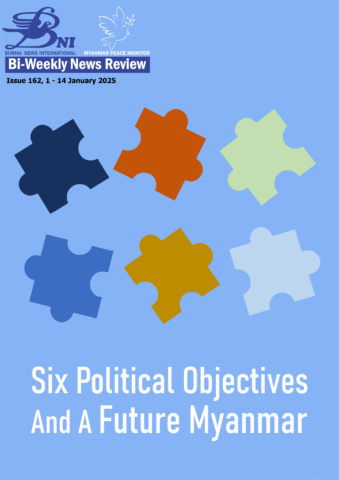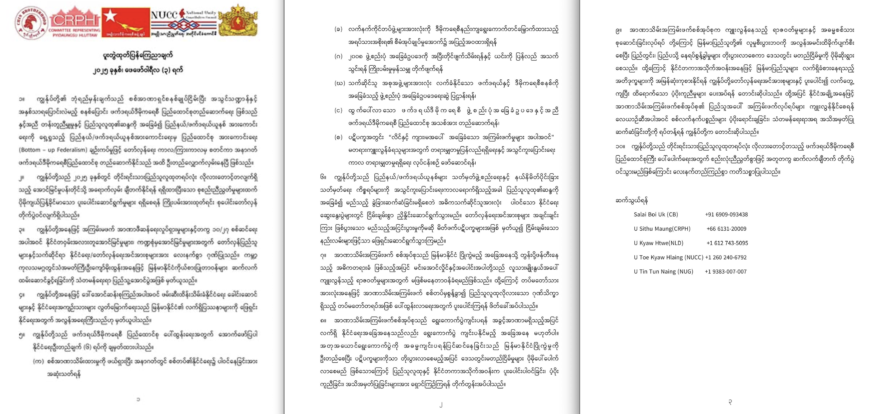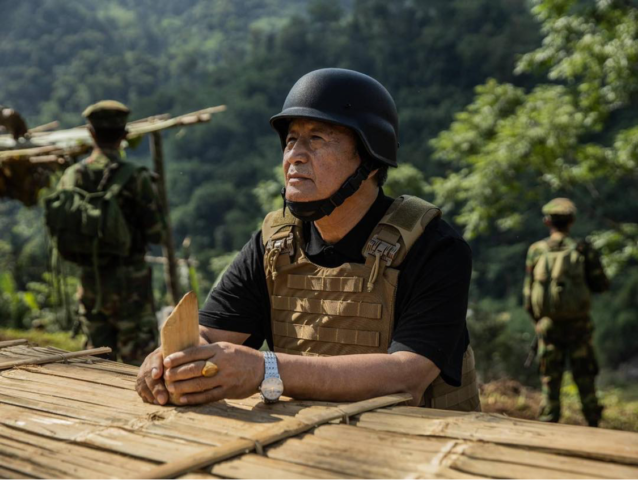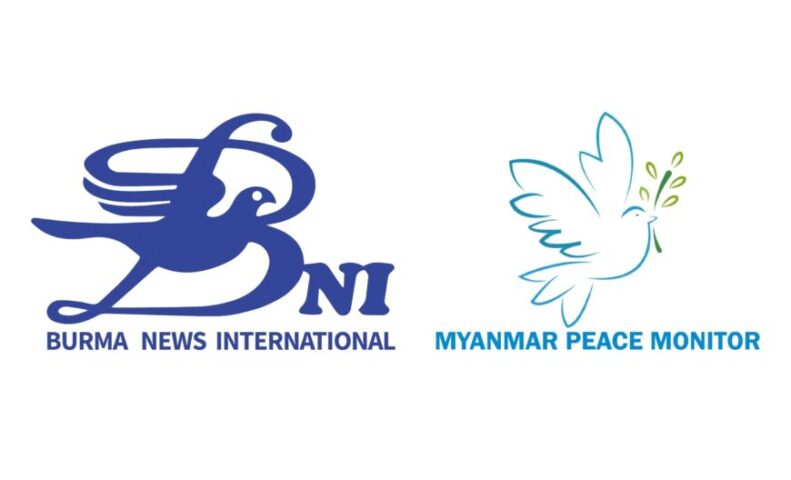
Introduction
As revolutionary forces have expanded their territorial control by capturing more camps and towns from the military junta since the coup, political discussions among revolutionary forces have been occurring sporadically. Although not all groups have come to the same round table yet, it is understood that they are taking steps towards a political shift.
This week’s Burma News International (BNI)-Myanmar Peace Monitor Bi-Weekly News Review looks at the six political objectives that revolutionary forces now mutually understand and accept, and their visions for a future federal union.
Joint statement
On 3 February 2025, the Chin Brotherhood (CB), the Committee Representing Pyidaungsu Hluttaw (CRPH), the National League for Democracy (NLD), the National Unity Consultative Council (NUCC), and the National Unity Government (NUG) issued a 10-point joint statement.

The five organizations have declared they are engaged in a collective revolutionary struggle, seeking to expand and strengthen cooperation beyond current efforts. They advocate for a ‘bottom-up federalism’ based on equality and the people’s will, aiming to strengthen state/federal units to build a robust union from the revolutionary or interim period until a federal democratic union is established. 1
According to the joint statement, issues regarding the designation of states/federal units and boundary demarcation will be settled during the transition period through an all-inclusive political dialogue. This dialogue will involve all significant stakeholders, reflecting the people’s will and ensuring no discrimination. They pledge to handle any disputes among revolutionary forces as partner disagreements, resolving them solely through peaceful means.
These revolutionary groups consider the release of detained political leaders, including Daw Aung San Suu Kyi, and all political prisoners to be vital in addressing current issues. They have outlined the following six political objectives for establishing a federal democratic union: (a) To eliminate the military coup and prevent any future military involvement in politics; (b)To place all armed forces entirely under the control of a democratically elected civilian government; (c) To permanently abolish the 2008 Constitution and resist any efforts to revive it; (d) To draft and implement a new constitution based on federal and democratic principles, acceptable to all stakeholders; (e) To construct a new federal democratic union according to the principles of this emerging constitution; (f) To carry out transitional justice and provide justice for victims, including those who have suffered from ‘sexual and gender-based violence’ during the conflict.
The joint statement urges both the people of Myanmar and the international community to neither participate in, support, nor recognize the military junta’s attempts at holding elections, warning that such actions contribute to the nation’s disintegration. They appeal to the international community to collaborate with resistance forces to offer practical and effective aid to alleviate the current suffering in Myanmar swiftly. Additionally, they call for an end to the supply of military equipment, including aviation fuel, and the withdrawal of diplomatic recognition from the military junta.
The joint statement concludes with a pledge to continue to fight together for the emergence of a federal democratic union.
How does it differ from the K2C + NUG joint position statement?
The six political objectives listed in the joint statement by the five organizations, including the CB, are virtually identical to those in the ‘Joint Position Statement by Allied Organizations Engaged in Revolutionary Struggle towards Annihilation of Military Dictatorship and Establishment of a Federal Democratic Union,’ which was issued on 31 January 2024, by the CNF, KNPP, KNU, and NUG. 2
The only notable change is found in point (f), where the phrase ‘to provide justice and transitional justice for victims of conflict-related abuses’ has been replaced with ‘to carry out transitional justice and provide justice for victims, including those who have suffered from sexual and gender-based violence during the conflict.'”
However, the K2C+NUG joint position statement includes nine points, expanding beyond the six shared objectives. It also declares the military coup illegal and condemns it, deems the 2008 Constitution illegal, prohibits future military involvement in political processes, and ensures that relevant political organizations involved in the anti-dictatorship revolution will have collective leadership in post-revolutionary state-building.
In addition, the K2C+NUG agreement outlines steps to exert pressure on the military junta, both militarily and politically, from both within and outside the country, along with the process for ending the military coup and transferring power, should the military junta agree to the six political objectives mentioned above.
NUG’s Acting President Duwa Lashi La has stated that the Kachin Independence Organization (KIO) was also included in the joint statement alongside K2C+NUG.

“At the moment, this shared agreement represents firmly established common ground among our allied ethnic organizations, known as K3C, which includes the KIO, KNU, KNPP, and CNF. We must continue striving for a unified agreement among them. I would like to emphasize that it’s also crucial to take into account the role of the Three Brotherhood Alliance in this aspect.” 3
Stance of the EROs and state/ethnic representative councils
On 19 September 2024, nine organizations, comprising three Ethnic Revolutionary Organizations (EROs) and state/ethnic representative councils, issued a statement on building a future federal democratic union. These nine organizations included the CNF, KNPP, KNU, Karenni State Consultative Council (KSCC), Pa-O National Federal Council (PNFC), New Mon State Party-Anti-Dictatorship (NMSP-AD), Mon State Federal Council (MSFC), Ta’ang Political Consultative Committee (TPCC), and Women’s League of Burma (WLB).
The nine organizations have agreed to collaborate from the revolutionary or interim period to develop their respective state/ethnic representative councils and Ethnic Revolutionary Organizations (EROs) using a bottom-up federalism approach. This approach focuses on strengthening states to construct a federal democratic union. They also laid down the following three foundational principles for bottom-up federalism: (a) The original owners of sovereign power are the state/federal units and their people; (b) These state/federal units are founded on principles of equality and the right to self-determination; (c) The distribution of powers will be conducted in line with the principles of sovereignty, solidarity, subsidiarity, and proportionality.” 4
Review
The 10-point joint statement by the five organizations, including the Chin Brotherhood (CB), encompasses both the six political objectives from the K2C+NUG shared agreement and the endorsement of the bottom-up federalism approach as advocated by the nine organizations.
Furthermore, the statement acknowledges the revolutionary forces behind various successful initiatives throughout Myanmar, such as the Civil Disobedience Movement (CDM), Operation 1027, and accomplishments in military, political, and international arenas. At the same time, it highlights conflicts and disputes among revolutionary forces in different regions.
However, the term “confederation” as proposed by the Arakan Army (AA) has not yet been included in any of the joint agreements, statements, or positions discussed above. It is noteworthy that out of the 95 towns under the control of revolutionary forces post-coup, the AA holds 25 towns in Arakan and Chin States. 5
Due to mediation and pressure from the Chinese government, the primary groups behind Operation 1027 – Myanmar National Democratic Alliance Army (MNDAA) and TNLA – have kept channels open for talks with the military junta. The AA has also expressed its willingness to resolve the situation through political means.
Over these four years of struggle against military dictatorship and towards the establishment of a federal democratic union, revolutionary forces have achieved military successes and extended their territorial control across both highland and lowland areas. Alongside these military gains, diverse aspirations and visions for the future among different regions and ethnic groups have come to the forefront.
Whether it is the joint statement by the five organizations, including the CB, the agreement between K2C and NUG, or the position statements from the nine organizations, all aim to establish a future federal democracy and dismantle the military dictatorship. However, efforts must be made by all parties to negotiate and engage with other revolutionary forces, ensuring their inclusion in these political objectives and stances.
The current six political objectives and the positions can be seen as outlining the blueprint for a future Myanmar.
1 Joint Statement, CRPH, 3 Feb. 2025
2 Joint Position Statement by Allied Organizations Engaged in Revolutionary Struggle towards Annihilation of Military Dictatorship and Establishment of a Federal Democratic Union, KNU, 31 Jan. 2024
3 NUG Acting President: KIO included joint position statement; 3BHA’s stance is also important, 6 Feb. 2024
4 Position statement by EROs and state/ethnic representative councils on building future federal democratic union, KNU, 19 Sep. 2024
5 95 towns captured and controlled by revolutionary forces, BNI-MPM Data, 8 Jan. 2025
